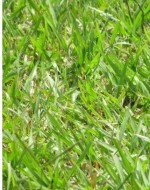 A native of Mexico and South America, Bahia grass is a coarse, open warm-season grass that produces a low to medium quality turf. It is widely grown for forage in Florida which gives you some idea of its potential as a lawn. One of the main problems is that it produces an abundance of seed heads in summer and fall that need to be removed if the lawn is to be kept tidy and attractive. This means regular mowing. In addition, it is not tolerant of heavy use and can be invasive. On the plus side, it thrives in hot humid areas with a good supply rain, is somewhat shade tolerant, and grows well on infertile soil. Argentine bahai grass is the preferred variety for lawns due to its low height, wide leaves, dark green color, and tendency to produce less seed heads than other bahia grasses. This variety, however, is not cold hardy and is suitable only for the deep South.
A native of Mexico and South America, Bahia grass is a coarse, open warm-season grass that produces a low to medium quality turf. It is widely grown for forage in Florida which gives you some idea of its potential as a lawn. One of the main problems is that it produces an abundance of seed heads in summer and fall that need to be removed if the lawn is to be kept tidy and attractive. This means regular mowing. In addition, it is not tolerant of heavy use and can be invasive. On the plus side, it thrives in hot humid areas with a good supply rain, is somewhat shade tolerant, and grows well on infertile soil. Argentine bahai grass is the preferred variety for lawns due to its low height, wide leaves, dark green color, and tendency to produce less seed heads than other bahia grasses. This variety, however, is not cold hardy and is suitable only for the deep South.
Light: Sun to partial shade
Water: Deeply and infrequently; tolerates some drought
Method of Reproduction: Sod; seed at the rate of 8-10 pounds/1000 sq ft.
Mowing: 2-3” every 5-7 days during the active growing season
Fertilizing: 2-4 pounds nitrogen/1000 sq ft.
Disease Tolerance: Generally disease and pest tolerant but susceptible to dollar spot, brown patch, and mole crickets.
Wearability: Moderate (not a good choice for high use areas)
Thatch: Low tendency to produce thatch.
Outstanding Selections:
-
Argentina (best for deep South)
Pensacola (more cold hardy than Argentine)
